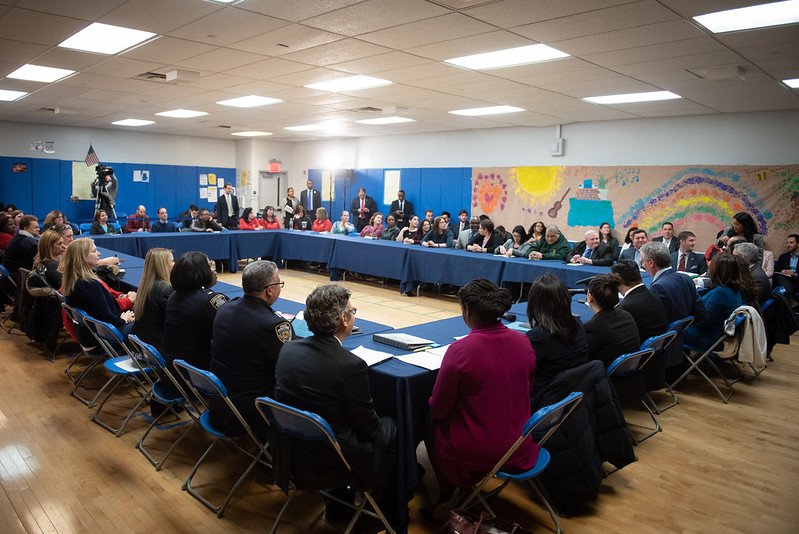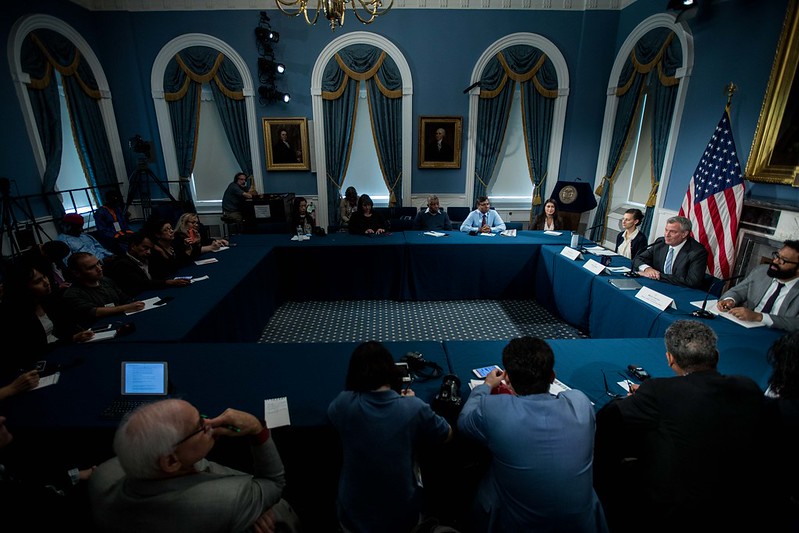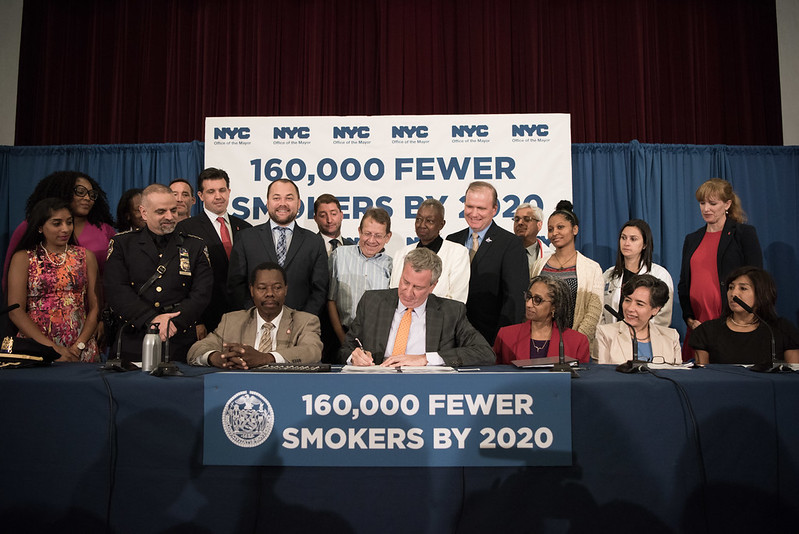Neighborhood Equity Ownership Plans: How Would They Work?

(photo: Michael Appleton/Mayoral Photography Office)
[This article is a follow-up to Dr. Goodman’s August op-ed: Replacing Unsuccessful ‘Community Benefits Agreements’ with Neighborhood Stock Ownership Plans]
How can neighborhoods defend themselves against displacement, gentrification, and disempowerment in an age of corporate domination? How can communities fend off rezoning, upzoning, and the usurping of neighborhood identity? Most people agree that Community Benefits Agreements (CBAs) don’t work for communities facing dislocation. Historically, these agreements have been tools used by developers to attenuate neighborhood opposition to mega-projects like stadiums, shopping malls, and corporate hubs. Though they come in different forms – jobs, contributions to community nonprofits, free tickets – CBAs are all the same. They are handouts used to cool community opposition to a developer’s project.
For decades, community groups, community boards, and public advocates have been victimized by the CBA strategy. These agreements force community leaders to jockey for ‘their’ benefits and to ignore the development of the community as a whole. But, the CBA model is ill-fitted to the contemporary development landscape of impact investors, opportunity zones, and a renewed sense of community empowerment. CBAs are unenforceable by the community, and to the developer, they are nothing more than the cost of doing business.
I am proposing a new model for communities facing off with developers: the Neighborhood Equity Ownership Plan (NEOP), modeled on the employee stock ownership plans in the private sector where one out of every five workers owns stock or stock options in the business.
This new strategy can help communities compete with a developer’s hired guns -- lobbyists, public relations professionals, and community liaisons. As lobbyists strive for zoning variances, publicists attempt to create a development narrative and as liaisons try to co-opt indigenous leaders, neighbors can promote partnership and avoid being derided as NIMBYs.
The formula for a successful Neighborhood Equity Ownership Plan could be as follows: 51 percent of the project’s stock would be allocated to the developer; 24 percent of the stock would be held by the government; and 25 percent would be owned by those who live, work, own businesses or property in the neighborhood and by nonprofits.
The logic is simple. Developers want control and a return on their investment that is economically viable. But they need government and community partners. For developers, the government provides necessary infrastructure investments, regulatory oversight, permits, and zoning variances. For these expenditures it is entitled to an ownership slice. The host neighborhood will absorb the impact of construction marked by truck traffic, noise and air pollution. Residents and employees will suffer from the loss of public space. Businesses will likely experience a decline in foot traffic. Nonprofits will confront increased social disruption. Stock ownership will serve as a repayment for these and other disruptions to daily life.
Neighborhood equity options would be divided among residents, employees, business owners, property owners, and nonprofits. Here the distributions would allocate 5 percent of the stock to each shareholder category. Residents and employees would be entitled to purchase shares of the corporation based on the longevity of their ‘investment’ in the neighborhood. People who have lived or worked in the community for 20 years or more, for example, would be entitled to purchase twice as many shares as those who have ten years invested in the district. Business and property owners would receive shares according to their annual revenues or assessed value. And, finally, nonprofits would be ‘gifted’ 5 percent of the shares of the corporation based on the number of students, seniors, or clients served.
The proposal for a soccer stadium in the Bronx provides a great example of the benefits that could be derived for the community from a neighborhood ownership plan.
A River Avenue Stadium Corporation would be created with equity shares available as indicated above. When naming rights are sold, when broadcast fees are collected, when merchandising agreements are made, or when sponsorships and suites are sold, revenue would pour into the corporation and be distributed as dividends accordingly.
As it stands currently, the benefits of these revenue streams would bypass those most impacted by a home for a private corporation owned by the world's third wealthiest person, China, the Yankees, and Silver Lake Management, a private equity firm.
More than 30 million Americans already own part of their employer company through stock or stock options. They derive dividends, vote for directors, and profit from the business’ success. This formula, if applied to a changing neighborhood, could reinvigorate corporate-community relations. It could refocus developers towards a more expansive definition of profit. It would convert stakeholders to shareholders. With the government and the neighborhood as shareholders, the needs of the community can be safeguarded.
***
Dr. Cary Goodman holds a post-doctoral certificate in development from The United Nations and is the executive director of the 161st Street BID.
***
Have an op-ed idea or submission for Gotham Gazette? Email This email address is being protected from spambots. You need JavaScript enabled to view it.
Letter to the Editor: The City’s Pattern of Evasion on Tech Contract

(photo: Benjamin Kanter/Mayoral Photo Office)
To the Editor:
New York City’s Chief Procurement Officer, Dan Symon, didn’t address any of the questions we’ve been raising about the $30.5 million Ivalua e-procurement contract scandal in his recent Gotham Gazette op-ed responding to my earlier piece.
As Director of the Mayor’s Office of Contract Services (MOCS), he continues to protect those responsible for this flimflam and prevent them from being held accountable.
If the city ran an “open competitive bidding process,” as Symon states, why not release public documents that prove it? Why shield them from the public for more than a year?
Our First Amendment attorney, Dave Schulz of Ballard Spahr, has repeatedly tried to contact MOCS Assistant General Counsel and Records Officer Janet Kim, but has not even gotten the courtesy of a reply. This is after several attempts of my own, leaving us with no choice but to retain legal counsel to help Checks & Balances Project obtain records about how this lucrative contract award first came to be.
We’ve requested records from only two former MOCS employees but have repeatedly received automated emails that put off providing us with records due to the “complexity” of our request. Again, we’re asking for emails from only two accounts.
Last year, we waited nine months to be told MOCS had no records. So, we simplified our request. Yet MOCS is referred to in the Ivalua contract 75 times and described as “the City’s central compliance and oversight agency for procurement.”
There are serious questions that Symon doesn’t want to answer that we are determined to pursue on behalf of New York City taxpayers:
Why was a French technology company that had never worked with any government in the U.S. given a $30.5 million contract by the largest municipality in the nation?
Was it because they partnered with powerful KPMG lobbyists who have deep ties to the Mayor and other city officials?
Symon claims the original 2016 contract was expanded “based on the success of early system releases and the demand from our stakeholders.” In fact, when the contract was expanded by $15 million in 2018, the design wasn’t done and “executive sponsor” KPMG had been fired, according to the limited public records produced by DoITT. Isn’t it more likely that the $15 million was given to Accenture, who replaced KPMG?
Symon tries to discredit Dallas, Texas’ $49,900 e-procurement system, built by Bonfire Interactive of Canada. But consider that if one day Ivalua, Accenture, and MOCS do finally finish an end-to-end e-procurement system for the 40 agencies as originally promised, New York City taxpayers will pay more than $1 million per agency. That’s compared to about $3,300 per agency in Dallas. Both systems can handle $15 billion-plus in annual spending by city agencies, yet why does New York City’s system cost nearly 340 times more?
We’re not arguing that an e-procurement system for New York City is a bad thing. But it is a bad thing if city taxpayers were ripped off by some kind of insiders’ deal. Public records should tell us if that’s true. Why won’t the city give them up?
Sincerely,
Scott Peterson, executive director of Checks and Balances Project, an investigative watchdog that seeks to hold government officials, lobbyists, and corporate management accountable to the public. On Twitter @CandBP.
***
Have an op-ed idea or submission for Gotham Gazette? Email This email address is being protected from spambots. You need JavaScript enabled to view it.
New York Lawmakers Must Consider Consequences of Banning Both Vaping Flavors and Menthol Cigarettes

(photo: Michael Appleton/Mayoral Photography Office)
The New York City Council recently voted to ban flavored e-cigarettes. Mayor Bill de Blasio will reportedly either sign the bill or let it pass into law. The City Council also considered a bill banning menthol-flavored traditional cigarettes but did not vote on the measure.
Still, energized by their legislative victory, anti-smoking activists continue to push for the menthol ban. Yet by banning all of these products, policymakers would both remove a legal alternative to menthol cigarettes and increase the likelihood of significant black market activity.
To be sure, smoking is terrible for you and has claimed an astounding number of lives. The motivation behind the ban proposals is thus both noble and understandable. But ban advocates have committed a fundamental error in reasoning: They assume that a ban will magically end all sales of menthols and flavored e-cigarettes. However, both economic reasoning and history suggest that bans often shift sales to an illicit market.
The reality is that people with strong consumer preferences tend to seek out certain products regardless of their legal status. And plenty of research shows that menthol smokers don’t find other cigarettes to be substitutable alternatives. Worse still, areas attempting to ban menthols — usually larger urban hubs — tend to have strong pre-existing infrastructure for illicit cigarette markets. In fact, New York is the “smuggled cigarettes capital” of the country. This suggests that if a menthol ban were imposed, a black market in menthols would spring up quickly and be difficult to eradicate.
Ban proponents respond by pointing to a survey in which 40 percent of menthol smokers indicated they would try to quit if a ban were instituted. But a study from a menthol ban in Ontario showed that while just under 30 percent attempted to quit in response to the ban, only 7 percent were successful.
The good news is that smoking rates have been trending downward for decades. And with the rising popularity of e-cigarettes, this trend could continue. Vaping products like e-cigarettes often serve as an alternative for menthol smokers looking to quit combustibles (traditional cigarettes that are burnt and smoked, not vaped). This is good for public health: Evidence suggests that these products are safer than combustible cigarettes.
Unfortunately, menthol ban advocates like those in New York often push just as strongly for bans on flavored vape products as they do for menthol bans. But in prohibiting the sale of both menthol cigarettes and flavored vaping or e-cigarette products, policymakers remove a healthier, legal alternative for menthol smokers looking to quit and thereby increase in the likelihood they will turn to the black market to obtain menthols.
Of course, there are no close substitutes for e-cigarettes either, so those consumers will likely choose illicit products as well. In a twist of tragic irony, the vaping black market is actually what has led to the recent outbreak of lung illnesses — not flavored products or even vaping itself. Former Food and Drug Administration head Scott Gottlieb acknowledged this fact when he said, “It appears that many of these acute lung injuries are being driven by illegal products that have oils in them.”
Illicit markets do more than just endanger consumers; their revenues often end up in the accounts of criminal syndicates and gangs. And to the extent any ban is effective, it will require police to stamp out illegal transactions. This puts both law enforcement and the communities they protect in tense situations, which tends to increase levels of mistrust. And neither group nor the larger society is served by a thriving black market.
Bans on vaping products and menthol cigarettes will not make communities safer. Rather than saving people from themselves, budding black markets could instead expose them to other harmful substances. Even as Governor Cuomo lists instituting and enforcing these bans as part of his 2020 agenda and as the New York City Council considers further prohibition, both the governor and the city’s leaders should acknowledge the possibility that waving a legislative wand does not make smoking disappear. Instead, by banning both products, they would be inviting a black market that endangers smokers, vapers, the police and the communities they protect.
***
Jonathan Haggerty is a Resident Fellow of Criminal Justice and Civil Liberties Policy at the R Street Institute. Jesse Kelley is R Street’s Criminal Justice and Civil Liberties Government Affairs Manager. On Twitter @Jhaggrid & @JessDKelley.
***
Have an op-ed idea or submission for Gotham Gazette? Email This email address is being protected from spambots. You need JavaScript enabled to view it.




